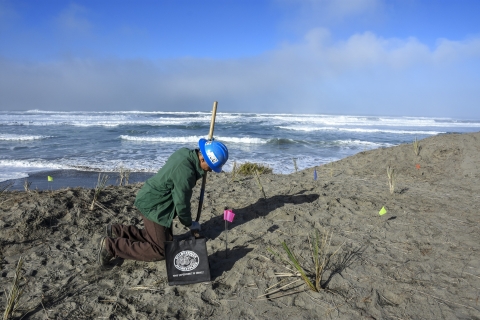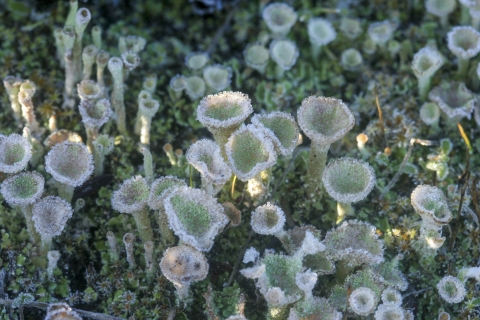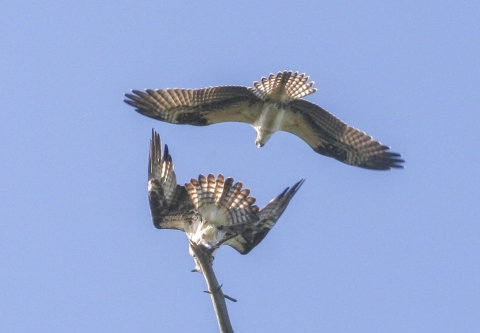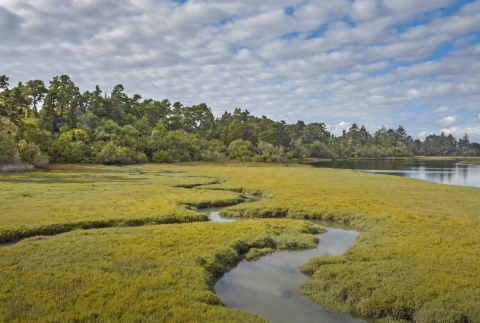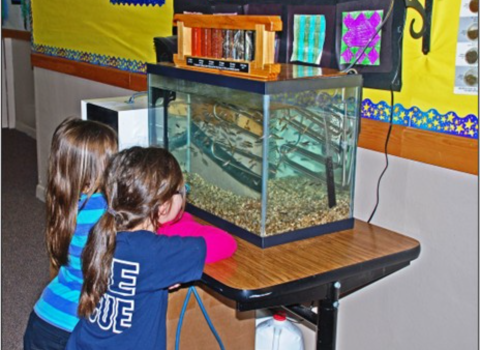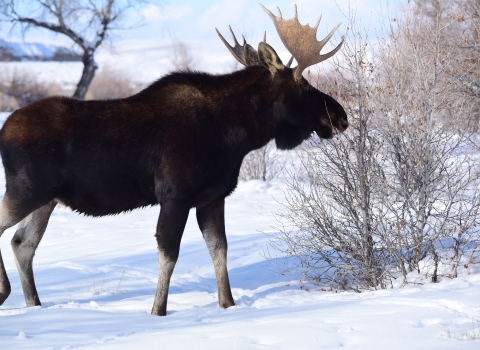After decades of hard work by U.S. Fish and Wildlife Service employees, volunteers, tribes and partners, and after two previous efforts in the '80s and '90s, the Lanphere and Ma-le’l Dunes were finally recognized as a National Natural Landmark National Natural Landmark
The National Natural Landmarks Program preserves sites illustrating the geological and ecological character of the United States. The program aims to enhance the scientific and educational value of the preserved sites, strengthen public appreciation of natural history and foster a greater concern for the conservation of the nation’s natural heritage. The program was established in 1962 by administrative action under the authority of the Historic Sites Act of 1935. The first National Natural Landmarks were designated in 1963. Today, there are more than 600 National Natural Landmarks in 48 states, American Samoa, Guam, Puerto Rico and the U.S. Virgin Islands.
Learn more about National Natural Landmark on January 19, 2021.
Managed by the Service and the Bureau of Land Management, the dunes are located west of Arcata in northwestern California, within the Humboldt Bay National Wildlife Refuge and Ma-le’l Dunes Cooperative Management Area. The site includes a diverse array of native vegetation and is known for several species of rare flora.
“Being recognized nationally really validates all the restoration work we’ve been doing in the dunes,” said Andrea Pickart, Service coastal ecologist for the refuge, of the efforts to remove invasive European beach grass and other species. “It is really exciting.”
“Andrea has been a driving force – such a dedicated, hardworking employee,” said Cashell Villa, Service project leader for the Humboldt Bay National Wildlife Refuge. “It is amazing, just incredible to be recognized.” The National Park Service, which administers the landmark process added: “Andrea has been working to conserve, restore and protect this site for over 30 years and deserves a large amount of credit for this project.”
Conservation of the area started in the 1940s by Hortense and William Lanphere “who were determined to conserve the property,” per Pickart. In 1976, the Lanpheres, who were both professors at what is now Humboldt State University in the Wildlife Department, donated the land to The Nature Conservancy who expanded the territory further before transferring to the Service in 1997.
Climate change includes both global warming driven by human-induced emissions of greenhouse gases and the resulting large-scale shifts in weather patterns. Though there have been previous periods of climatic change, since the mid-20th century humans have had an unprecedented impact on Earth's climate system and caused change on a global scale.
Learn more about climate change on the dunes and develop strategies to increase resilience. Credit: Andrea Pickart/USFWS
In addition to the Lanpheres, “Ma-le’l” is named after one of several Wiyot tribal villages within the dunes in 1850, an area known for its abundant huckleberry harvest, and as ethnographer Llewellyn Loud noted was “visited annually in September, during the huckleberry season.”
“I think that the significance of the designation of the dunes as a NNL is in part an homage to the Wiyot’s role and history as stewards and members of this place and the natural world,” said Adam Canter, tribal botanist/GIS specialist for the Wiyot Tribe Natural Resources Department. “If ever there were a people of the dunes in California, that title could very well go to the Wiyot.
“Hopefully this will ensure that funding for maintenance restoration, Wiyot eco-cultural restoration, and ecological research will be maintained into the future. Having worked at Lanphere and Ma-le’l, I appreciate and understand the hard work of many that have contributed to the preservation of the natural characteristics and processes at the dunes. Hopefully this designation will provide increased opportunities for the Wiyot to continue co-managing and stewarding its ethnobotanical area and provide eco-cultural restoration opportunities for Wiyot youth.”
Marnie Atkins, the Wiyot tribe’s Da gou rou louwi' Cultural Center manager added, “The dunes are special to me because it is a direct connection to my Wiyot ancestors. I can see where they lived, and I can follow in their footsteps along the paths that they made and that the BLM and Service personnel and community volunteers recovered from overgrowth and underuse. It is true that the landscape holds varieties of plant life that will continue to be enjoyed, understood and protected to maintain important biodiversity and animal habitat. It is a location that partnerships can be built through land management and stewardship work.
“Further, Ma-le'l is a place that illustrates the cultural significance and historical activities that happened on the land by the ancestors of present-day and future Wiyot people. Ultimately, it is a place that demonstrates and validates the connection to the lived landscape that my Wiyot ancestors constructed over thousands upon thousands of years.”
The landmark process, which started in 2016 for the dunes, recognizes and encourages the conservation of sites that contain outstanding biological and geological resources. According to the Park Service’s evaluation, “the Lanphere Ma-le’l Dunes represents a perfect example of this concept, containing one of the most diverse and highest quality remnants of coastal dunes in the North Pacific Border Bio Physiographic Region.”
Executive director of the Friends of the Dunes, Mike Cipra, said the complex at Lanphere and Ma-le’l Dunes contains dynamic interrelated habitats, including foredunes, herbaceous and woody swales, freshwater wetlands, parabolic dunes, coniferous and riparian riparian
Definition of riparian habitat or riparian areas.
Learn more about riparian forest, and saltmarsh. “This exciting mosaic of healthy, intact habitats yields a tremendous amount of floristic diversity in a relatively small area. As a result, this integrated ecosystem is a wonderland for exploration, inspiration and learning.”
Canter agreed: “The removal and absence of invasive non-native species makes this site one of the most pristine stretches of dune systems along the west coast. In addition to these natural values, is the rich history of the Wiyot’s occupation of the dunes. While being close to the cities of Arcata and Eureka, Lanphere and Ma-le’l still maintain wilderness characteristics and place for relaxation, introspection, and solace.
“Along with the plant and lichen diversity found in the dunes, this landmark provides a rare glimpse at what the west coast would have been like before western contact, while also serving as a refugium for species more commonly found further north. Ma-le’l is also one of the more significant Wiyot ethnobotanical sites within the tribe’s ancestral territory.”
The dunes also afford the public an inspiring view of a natural coastal ecosystem that was once common along the western coast.
“The benefit I see for the community is recognition and publicity, which could lead to increased use and a greater investment in this unique resource,” said Pickart.
“This shines the light on just how rare these systems are,” said Tom Anderson, Service assistant refuge supervisor for the California-Great Basin Region. “I’m glad it is getting the recognition it deserves. It is so far away from everything else. This designation might draw more people to the other side of the bay now.”
The Blue Lake Rancheria has collaborated and consulted with the Service on managing the numerous important cultural sites located at Ma-le'l Dunes and the new Northern Dunes Unit. Janet Eidsness, tribal historic preservation officer has coordinated with Pickart, the Wiyot tribe and Bear River Band of the Rohnerville Rancheria on developing site protection measures for vegetation management plans including removal of non-native European beach grass and yellow lupine to allow for the natural migration of the parabolic dunes.
Salt marshes are found in tidal areas near the coast, where freshwater mixes with saltwater.
Learn more about salt marsh species including two rare species. Credit: Andrea Pickart/USFWS
“If not for these dunes, there would be no Humboldt Bay and their natural patterns are important to resiliency related to rising sea levels,” said Eidsness.
“Those of us who work in coastal conservation, who lead community-based education and stewardship programs here, and who recreate in these restored dune ecosystems know how truly unique and inspiring the Lanphere and Ma-le'l Dunes are,” said Cipra. “We're thrilled that this connected and conserved landscape is finally being recognized as nationally significant. The recent National Natural Landmark designation is a tribute to our partners at the U.S. Fish and Wildlife Service, the Bureau of Land Management, the Wiyot tribe, and literally thousands of community members who have worked for years to conserve and restore these special places.”
Molly Brown, field manager with the Bureau of Land Management agreed. “We have been happy to work with the Service and our partners at neighboring Lanphere Dunes to conserve this important dunes ecosystem. We are absolutely thrilled that this locally popular natural area has been recognized as a National Natural Landmark and look forward to the American public enjoying this unique, living landscape for generations to come.”


